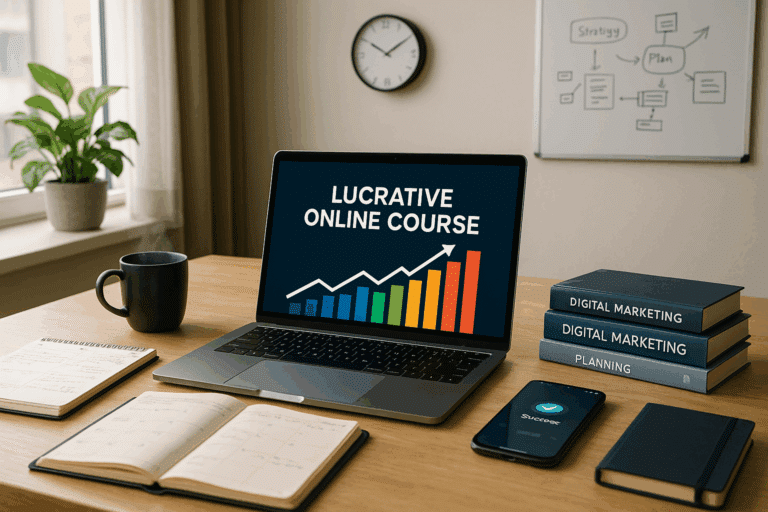🚀 The ability to share your knowledge with the world, and the potential for a solid stream of passive income, is an appealing proposition for many. But as many course creators soon find out, getting people to actually purchase the course can be the most challenging part. This is where the art of pre-selling comes into play.
So, what exactly is pre-selling, and how can it help boost your online course success? Simply put, pre-selling is the strategy of promoting and selling your product before it is fully launched. This can create a sense of excitement and urgency around your product, and generate some much-needed revenue to fuel further development. But mastering the art of pre-selling is no small feat, and that’s where this guide comes in. 🎯
In this comprehensive blog post, we’ll delve deep into proven strategies for pre-selling your online course. By the end, you’ll have a clear understanding of how to effectively pre-sell your course, generate buzz, and maximize your launch success.
Understanding the Power of Pre-Selling 💪
The first part of our exploration will be focused on understanding the concept of pre-selling. We’ll look at the benefits and why it is such a powerful tool for online course creators. Pre-selling not only tests the waters for your course, but it also reduces the risk of spending time and resources on a course that may not sell. It helps in building a community of early adopters who are invested in your success and are more likely to become loyal customers and brand advocates.
Developing a Solid Pre-Selling Strategy 🗒️
Next, we will delve into the nitty-gritty of developing a robust pre-selling strategy. This includes defining your target audience, crafting compelling messaging, and choosing the right pre-selling methods. You’ll learn how to identify potential customers, understand their needs and pain points, and present your course as the perfect solution.
Executing a Successful Pre-Selling Campaign 🚀
Finally, we’ll guide you through the practical steps of executing a successful pre-selling campaign. From creating a landing page that converts, to leveraging social proof, and managing customer feedback, you’ll discover actionable steps that you can apply directly to your own pre-selling efforts.
Whether you’re just starting out with your first online course, or you’re an experienced course creator looking to boost your success rate, pre-selling can be a game changer. With the right strategies, it can help you validate your course idea, build a dedicated community of learners, and secure a solid income even before your course officially launches. So, are you ready to master the art of pre-selling and boost your online course success? Let’s get started! 🎯
Understanding the Basics of Pre-Selling
Before we delve into the meat of the topic, it’s important to grasp the basics of pre-selling. It is a technique where you begin marketing and promoting your online course before it’s even finished. This strategy is effective in generating buzz, building anticipation, and gauging interest in your course. But how exactly does pre-selling work, and what makes it a powerful tool in the online course industry? Let’s find out!
Pre-selling serves a dual purpose. On one hand, it acts as a marketing strategy to stir interest and excitement about your upcoming course. On the other hand, it serves as a litmus test to gauge the potential success of the course. By pre-selling, you can gather insights into the market demand, allowing you to refine and tailor your course to meet the specific needs and expectations of your target audience.
From a business standpoint, pre-selling can also secure early revenue that can be funneled back into course development. This can enhance the quality of your course, as you can invest in better resources, tools, or expert assistance.
Video Resource:
Title: The Power of Pre-Selling
Channel: Teachable
Note: Please search and watch the video on YouTube for more insights about the importance of pre-selling.
The Proven Pre-Selling Strategies for Online Courses
Now that we’ve covered the basics, it’s time to explore the effective strategies for pre-selling your online course. The success of your pre-selling efforts greatly depends on the strategies you deploy. In this section, we’ll explore proven pre-selling techniques that have worked for countless successful online course creators.
The first step in pre-selling is building an audience. Your audience is your pool of potential customers, so it’s essential to build an engaged and relevant audience. Start by creating high-quality, value-packed content that attracts and resonates with your target audience. You can do this through blogging, guest posting, social media posting, podcasting, or any other content marketing strategy.
Secondly, establish your authority and credibility in your niche. People buy from those they trust, and demonstrating your knowledge and expertise in your field can foster that trust. One way to establish authority is by offering free valuable content like e-books, webinars, or reports that showcase your expertise. Remember to always provide value first before asking for a sale.
Comparing Pre-Selling with Traditional Selling
Now let’s see how pre-selling stacks up against traditional selling. While both have their merits, pre-selling offers distinct advantages when it comes to selling online courses.
| Pre-Selling | Traditional Selling | |
|---|---|---|
| Risk Level | Low risk as you’re testing the waters before full investment. | High risk as you’re investing time and money upfront. |
| Customer Engagement | High engagement as the anticipation builds. | Lower engagement without the build-up. |
| Feedback Opportunities | Feedback is gathered early to refine the course. | Feedback is gathered post-sale, limiting refinement opportunities. |
Video Resource:
Title: Pre-selling vs Traditional Selling
Channel: Thinkific
Note: Please search and watch the video on YouTube for more comparison between pre-selling and traditional selling.
Master the Art of Pre-Selling: Step-by-Step Guide
Now we’re getting to the good stuff – a step-by-step guide to mastering the art of pre-selling. Here, we will break down the pre-selling process into manageable steps.
Step one is identifying your target audience. This involves understanding who they are, what they want, and how your course can help them. A clear understanding of your target audience is crucial in shaping your course and marketing strategy.
Step two is building an email list. Your email list is your direct line of communication with your potential customers. To build your list, you can offer a free resource in exchange for their email address.
Finally, the third step is launching your pre-sale. This involves announcing your course, outlining the benefits, and offering an incentive for early adopters. Remember, the goal of pre-selling is not just to generate sales, but also to gather feedback and refine your course.
Video Resource:
Title: Step-by-Step Guide to Pre-Selling
Channel: Kajabi
Note: Please search and watch the video on YouTube for a detailed guide on pre-selling.
Tips and Tricks to Boost Your Pre-Selling Success
Finally, let’s look at some tips and tricks to boost your pre-selling success. The success of your pre-sale largely depends on how effectively you implement your strategies.
Firstly, offer an early bird discount to incentivize purchases. This can increase your conversion rate as customers perceive they are getting a bargain.
Secondly, keep your audience updated with the progress of your course. This not only builds anticipation but also keeps your course at the top of their minds.
Lastly, consider offering a money-back guarantee. This reduces the perceived risk for your customers, making them more likely to purchase your course.
Video Resource:
Title: Tips and Tricks to Boost Pre-Selling
Channel: Podia
Note: Please search and watch the video on YouTube for more tips and tricks on pre-selling.

Conclusion
After a detailed and comprehensive journey through the world of software engineering, we arrive at the end of our discourse. Our voyage has taken us through the essential aspects of this field, exploring the concepts, methods, and applications that shape it. 💡
In the beginning, we introduced the concept of software engineering and explored its historical background, highlighting its importance as a distinct field of engineering and its role in the development of modern technology. Through extensive research, we have made it clear that software engineering is not merely coding but a complex process of designing, implementing, and maintaining software systems.
We have then delved into the different methodologies that are instrumental to software engineering, from Waterfall to Agile, each with their unique advantages and situations where they shine the most. We have stressed the importance of selecting the right methodology for the right project, taking into account the project’s requirements and constraints.
In addition, we have examined the critical role of testing in software engineering, explaining how it ensures the reliability and efficiency of software systems. We’ve also emphasized the need for continuous learning and adapting in this fast-paced field, suggesting resources like online courses and tutorials for continual professional development.
Furthermore, we highlighted how software engineering is intertwined with various sectors, from healthcare to entertainment, reinforcing its significance in our daily lives. The transformative power of software engineering is indeed undeniable.
Before wrapping up, we had a peek into the future of software engineering, discussing emerging trends like Artificial Intelligence and Machine Learning, and how they are poised to revolutionize the field. 🚀
Reflecting on our journey, it becomes evident that software engineering is a dynamic and ever-evolving field, full of challenges, but also opportunities.
As we conclude, we invite you to ponder on the immense potential that software engineering holds. Whether you are a seasoned professional or an aspiring engineer, we hope this article has provided you with valuable insights and stimulated your interest in further exploration.
We encourage you to share your thoughts, questions, or experiences in the comments below. Perhaps your insights could spark a discussion or inspire someone else in their journey. 👥
Remember, knowledge shared is knowledge multiplied. So, don’t hesitate to share this article with your colleagues and friends who might find it informative and helpful.
Lastly, we encourage you to apply what you’ve learned, experiment, and not fear making mistakes. After all, as Thomas Edison said, “I have not failed. I’ve just found 10,000 ways that won’t work.”
Let’s keep learning, growing, and transforming the world through software engineering! 💪
Stay tuned for our next deep dive. Until then, happy coding! 👨💻👩💻
Resources:
[1] Software Engineering: A Practitioner’s Approach by Roger S. Pressman
[2] IEEE Xplore: Software Engineering



